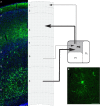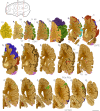The medial pulvinar: function, origin and association with neurodevelopmental disorders
- PMID: 30657169
- PMCID: PMC6704239
- DOI: 10.1111/joa.12932
The medial pulvinar: function, origin and association with neurodevelopmental disorders
Abstract
The pulvinar is primarily referred to for its role in visual processing. However, the 'visual pulvinar' only encompasses the inferior and lateral regions of this complex thalamic nucleus. The remaining medial portion (medial pulvinar, PM) establishes distinct cortical connectivity and has been associated with directed attention, executive functions and working memory. These functions are particularly impaired in neurodevelopmental disorders, including schizophrenia and attention deficit and hyperactivity disorder (ADHD), both of which have been associated with abnormal PM architecture and connectivity. With these disorders becoming more prevalent in modern societies, we review the literature to better understand how the PM can participate in the pathophysiology of cognitive disorders and how a better understanding of the development and function of this thalamic nucleus, which is most likely exclusive to the primate brain, can advance clinical research and treatments.
Keywords: cognitive disorders; primate; pulvinar.
© 2019 Anatomical Society.
Figures





Similar articles
-
Extensive Connectivity Between the Medial Pulvinar and the Cortex Revealed in the Marmoset Monkey.Cereb Cortex. 2020 Mar 14;30(3):1797-1812. doi: 10.1093/cercor/bhz203. Cereb Cortex. 2020. PMID: 31711181
-
Development of lateral pulvinar resting state functional connectivity and its role in attention.Cortex. 2021 Mar;136:77-88. doi: 10.1016/j.cortex.2020.12.004. Epub 2020 Dec 24. Cortex. 2021. PMID: 33486158 Free PMC article.
-
Pulvinar and other subcortical connections of dorsolateral visual cortex in monkeys.J Comp Neurol. 2002 Aug 26;450(3):215-40. doi: 10.1002/cne.10298. J Comp Neurol. 2002. PMID: 12209852
-
Dissociating emotion and attention functions in the pulvinar nucleus of the thalamus.Neuropsychology. 2015 Mar;29(2):191-6. doi: 10.1037/neu0000139. Epub 2014 Sep 1. Neuropsychology. 2015. PMID: 25180982 Review.
-
The functional logic of cortico-pulvinar connections.Philos Trans R Soc Lond B Biol Sci. 2003 Oct 29;358(1438):1605-24. doi: 10.1098/rstb.2002.1213. Philos Trans R Soc Lond B Biol Sci. 2003. PMID: 14561322 Free PMC article. Review.
Cited by
-
Effects of acute sleep deprivation on the brain function of individuals with migraine: a resting-state functional magnetic resonance imaging study.J Headache Pain. 2025 Mar 28;26(1):60. doi: 10.1186/s10194-025-02004-4. J Headache Pain. 2025. PMID: 40155843 Free PMC article.
-
Functional connectivity of thalamic nuclei during sensorimotor task-based fMRI at 9.4 Tesla.Front Neurosci. 2025 May 13;19:1568222. doi: 10.3389/fnins.2025.1568222. eCollection 2025. Front Neurosci. 2025. PMID: 40433501 Free PMC article.
-
Retinorecipient areas in the common marmoset (Callithrix jacchus): An image-forming and non-image forming circuitry.Front Neural Circuits. 2023 Feb 2;17:1088686. doi: 10.3389/fncir.2023.1088686. eCollection 2023. Front Neural Circuits. 2023. PMID: 36817647 Free PMC article. Review.
-
The Evolution of the Pulvinar Complex in Primates and Its Role in the Dorsal and Ventral Streams of Cortical Processing.Vision (Basel). 2019 Dec 30;4(1):3. doi: 10.3390/vision4010003. Vision (Basel). 2019. PMID: 31905909 Free PMC article. Review.
-
Brain-wide mapping of inputs to the mouse lateral posterior (LP/Pulvinar) thalamus-anterior cingulate cortex network.J Comp Neurol. 2022 Aug;530(11):1992-2013. doi: 10.1002/cne.25317. Epub 2022 Apr 6. J Comp Neurol. 2022. PMID: 35383929 Free PMC article.
References
-
- American Psychiatric Association (2013) Diagnostic and Statistical Manual of Mental Disorders (DSM‐5®). Arlington, VA: American Psychiatric Association.
-
- Amunts K, Lepage C, Borgeat L, et al. (2013) BigBrain: an ultrahigh‐resolution 3D human brain model. Science 340, 1472–1475. - PubMed
-
- Asanuma C, Andersen RA, Cowan WM (1985) The thalamic relations of the caudal inferior parietal lobule and the lateral prefrontal cortex in monkeys: divergent cortical projections from cell clusters in the medial pulvinar nucleus. J Comp Neurol 241, 357–381. - PubMed
Publication types
MeSH terms
Grants and funding
LinkOut - more resources
Full Text Sources

